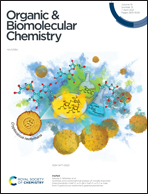Development of a 1,2-difluorofucoside activity-based probe for profiling GH29 fucosidases†
Abstract
GH29 α-L-fucosidases catalyze hydrolysis of terminal α-L-fucosyl linkages with varying specificity and are expressed by prominent members of the human gut microbiota. Both homeostasis and dysbiosis at the human intestinal microbiota interface have been correlated with altered fucosidase activity. Herein we describe the development of a 2-deoxy-2-fluoro fucosyl fluoride derivative with an azide mini-tag as an activity-based probe (ABP) for selective in vitro labelling of GH29 α-L-fucosidases. Only catalytically active fucosidases are inactivated by this ABP, allowing their functionalization with a biotin reporter group via the CuAAC reaction and subsequent in-gel detection at nanogram levels. The ABP we present here is shown to be active against a GH29 α-L-fucosidase from Bacteroides fragilis and capable of labeling two other GH29 α-L-fucosidases with different linkage specificity, illustrating its broader utility. This novel ABP is a valuable addition to the toolbox of fucosidase probes by allowing identification and functional studies of the wide variety of GH29 fucosidases, including those in the gut microbiota.

- This article is part of the themed collection: Chemical Biology in OBC


 Please wait while we load your content...
Please wait while we load your content...